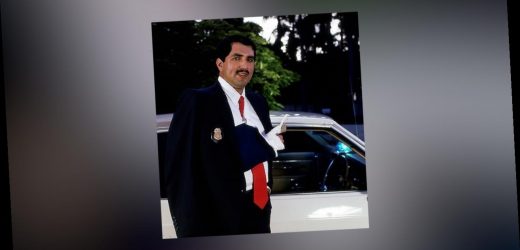Hero of 1986 FBI shootout on how incident reshaped law enforcement
Former FBI Special Agent Ed Mireles explains what leaders should examine in the wake of another deadly shootout.
A shootout with an armed suspect that left two FBI agents dead and two more hospitalized during a child pornography investigation in Fort Lauderdale, Fla., on the morning of Feb. 2, 2021, is drawing parallels to another deadly gunfight in the Sunshine State from 35 years ago.
FBI special agents Daniel Alfin, 36, and Laura Schwartzenberger, 43, were killed in the early-morning shooting on Feb. 2, 2021. Three others were hurt, two of them seriously.
(FBI)
A 1986 gunfight between FBI officers and two violent bank robbers in what is now Pinecrest, Fla., outside Miami, was among the deadliest in the bureau’s history, leaving two agents and both suspects dead and injuring another five FBI members.
Former FBI Special Agent Ed Mireles, who was shot twice in the encounter before neutralizing gunmen Michael Lee Platt and William Russell Matix, recounted his experience last week and explained how it led to reforms for both federal and local law enforcement agencies.
They fought to their last breath, OK, they fought, like wild, trapped animals.
The following interview has been edited for brevity and clarity.
FBI OVERHAULED WEAPONS, ARMOR FOR AGENTS AFTER DEADLY FLORIDA SHOOTOUT 35 YEARS AGO
FOX: You were involved in one of the FBI’s most horrific shootouts, in the history of the FBI, back in 1986, and it led to some changes for not only the FBI, but law enforcement agencies around the country. That was 35 years ago. Do you think those changes need an update now?
Ed Mireles: Any time there’s a deadly force confrontation between police, law enforcement officials and the public, it needs to be reviewed. That’s the law, and I support that 100%, because you want to make sure that that there were no crimes perpetrated by officers and that the shooting is within the law and deadly force policy set by the Supreme Court. But there’s always an opportunity for lessons learned.
And I’m sure that the investigation of the agents that were shot and killed in Sunrise down in South Florida is still ongoing. I haven’t heard anything that indicates that it’s been completed. But by the same token, I have not heard anything that that’s outstanding or glaring as far as any errors or mistakes that were that were carried out by the officers or caused by the officers.
FOX: The information that we have available, that was the suspect unexpectedly became violent and attacked them. And it really wasn’t it wasn’t a procedural problem or a tactical problem or anything like that.
FBI IDENTIFIES SLAIN AGENTS WHO ‘EXEMPLIFIED HEROISM’ IN FORT LAUDERDALE SHOOTINGS
EM: I don’t think it was a procedural or tactical problem. But you know what, though? That’s something that the public, I don’t think understands. I think a lot of people don’t understand that. I was asked by some other folks last week, ‘Hey, should there have been better preparation?’
And I can tell you from experience that law enforcement today is a heck of a lot more prepared. They have more structured operations policies, or arrest policies or search policies. In other words, you have to have a plan. Thirty-five years ago was like, ‘Hey, Bill, Joe, come on. Listen, I just got a tip. One of my fugitives is at the corner of 1st and Main. Let’s go let’s run down there and pick him up.’
That’s the way it used to be. Now it’s like you have to have an arrest plan and everything else. But what the public needs to understand is law enforcement can plan, and plan, and plan, you know, for days and weeks. But when you go to execute the warrant, you still have that unknown factor. You have human nature involved with the perpetrator. The subject has a say in the outcome, OK? And that’s something that law enforcement cannot control.
FLORIDA FBI AGENTS HURT IN DEADLY AMBUSH RELEASED FROM HOSPITAL
The subject, or the perpetrator, or the fugitive, or whatever term you want to call him or her — they have a say in the outcome. If that person says, ‘You know what, no way. I’ve been arrested too many times…I have nothing to lose.’ They can dictate the outcome of that shooting. And it’s like my incident back in 1986. You hear a lot of stories and movies, ‘Oh, they’ll never take me alive.’ One of those clichés, like a gangster movie from the ‘40s or something. But in our case, in 1986, we had two highly trained, physically fit, heavily armed killers. They had a track record of, by the time we ran into them face-to-face, they had already shot and/or killed at least five or six people.
It was really a ‘they’ll never take me alive,’ you know. And it took eight FBI agents, with everything we had, to try to corner them and subdue them. And the only way they went was on their backs. They fought to their last breath, OK, they fought, like wild, trapped animals, which is in reality what they ended up being: cornered-in rabid animals. Because they did not stop fighting until their last breath.
FOX: And that led to changes, right? In the weapons the FBI was given and other law enforcement agencies were given, and the caliber of ammunition used after that.
EM: Yes. I believe the word is a watershed event. That event broke the dam. As far as law enforcement equipment, law enforcement training, ballistics research. It just changed law enforcement, and it changed for the better.
We were armed with six shots, which was a standard-issued law enforcement weapon, except for special units like SWAT and undercover guys, and standard-issued shotguns. We came up against a couple of guys who were carrying revolvers. But one individual was carrying a shotgun, and his partner was carrying an assault rifle with 30-round magazines.
The individual who has a 30-round magazine has an advantage over an individual who has a six-shot revolver, because I would have to shoot and reload five times to equal 30 rounds. And every time you have to stop and reload, it’s time that you’re not fighting. It’s time that you’re not observing and looking and trying to get a tactical advantage on your adversary. So we learned that lesson the hard way.
The FBI and law enforcement went from there, did research into high-capacity pistols. We went from six shots to 15-shot pistols.
The FBI went out and purchased an MP5 submachine gun or a shotgun for every two agents. In other words, because agents are usually partnered up in a car, they wanted to have at least an MP5 submachine gun or a shotgun, for every pair of agents that the agency employed at the time.
Finally somebody started saying, ‘How do you quantify stopping power? How do you quantify knockdown power?’
They spent a lot of money, just on hardware and then the weapons research. And then they got more ballistics; they got more body armor. They researched improvement on the body armor, tactics, training.
And the big one was the ballistics testing. Up until that point, law enforcement was depending on the bullet manufacturers for their bullets. In other words, we had to take Remington or Winchester’s word on specific rounds. They would come up to you, say, ‘This round has stopping power, OK? Or this round has knockdown power, OK?’
And finally somebody started saying, ‘How do you quantify stopping power? How do you quantify knockdown power?’
It wasn’t until the FBI started doing reproducible research and detailed research into what bullets did and simulated and gelatin ballistic gelatin, which simulates human tissue. And they found out some interesting things.
They found out that some of those knockdown power bullets were not really that effective. So they got together with the manufacturers and they helped them design bullets that met certain parameters, certain criteria, that that would be acceptable for law enforcement.
That was huge, because Jerry Dove one of the agents who was killed in my incident, he shot the main perpetrator, the guy with the assault rifle, within the first minute of the gunfight. And that round has been debated for the last 35 years…
Special Agents Benjamin Grogan, 53, and Jerry Dove, 30, were killed by a pair of wanted murderers and robbers.
(FBI)
It was a very severe hit. It severed his brachial artery in his right arm, penetrated the right side of his chest and hit him in the lung. But it stopped about an inch and a half short of the heart…So he was shot within the first minute, and he kept fighting for an additional three to four minutes. We can only estimate he kept fighting for an additional three or four minutes, even though he was injured severely.
Like I said, he fought to his last breath. So that was the specific point that caused law enforcement to look at the ballistics. Why didn’t this individual stop with that devastating of a hit to his body?
FOX: That led to some kind of changes in how the FBI evaluated ballistics and the technology behind bullets, and that has changed over the years, too. So they changed the weapons that were given out to FBI agents, and they recently changed them again. But now they went down in size, back to a 9 mm. But the bullets are more high-tech, have more stopping power, as you were talking about.
EM: I have to admit, very candidly, I was surprised when I heard that happened. I’m thinking, the FBI went back to the 9 mm round, which to me was shocking because it was a 9 mm round in 1986 that failed to perform up to par…But then I did more research, and I contacted some good friends of mine in law enforcement and the FBI, firearms instructors or former firearms instructors and agents that are still currently on active duty. And I talked it out with them. I said, what’s going on?
They told me that they had done extensive research on the new 9 mm round… I’m told that it performs superbly, compared to the previous 9 mm rounds. I can see why the FBI or law enforcement would would change to that. After the incident, I started carrying a .45-caliber pistol. And if you compare a 45-caliber pistol round to a 9 mm pistol round, the .45 is almost 50 percent bigger.
I’m old fashioned, and old habits are hard to break, but I’m not set on the .45. If the 9 mm round or some other round comes up that’s as good or better, I’m all for it. I’m all for officer safety. That’s the bottom line.
If I hit somebody, it’s going to be a pretty devastating hit. But on the flip side, on the logistic side, you can carry twice as many 9 mm rounds than you can .45 rounds. So there’s advantages to having more bullets, as long as those bullets perform up to a set standard.
I’m all for that. I’m not a hardcore, die hard, .45-caliber guy. I’m just old school. I grew up in Texas. My dad taught me how to shoot with a .45 Colt 1911 back from World War II. I’m old fashioned, and old habits are hard to break, but I’m not set on the .45. If the 9 mm round or some other round comes up that’s as good or better, I’m all for it. I’m all for officer safety. That’s the bottom line.
2 FBI AGENTS DEAD, OTHERS INJURED IN FLORIDA SHOOTING WHILE SERVING WARRANT: SOURCE
FOX: Following the Feb. 2 shootings, do you have any advice for active duty law enforcement right now about anything that anything you could learn from this or that they should learn from this?
EM: It boils down to the human factor, human nature. When that perpetrator inside the apartment saw what was going to happen, he had to make a choice. Do I comply or not comply? That’s a choice law enforcement officers face every day, and if you choose not to comply, there is nothing I can do to change that. There is nothing a police officer can do to change a non-compliant person’s attitude other than fighting him, or beating him into submission, or if necessary, depending on circumstances, using deadly force to stop them.
We can always learn something. The Ring camera, that’s going to be a big learning point. For future arrests, you guys need to check the structure for cameras. And even then, if you check them, you may not know they’re there. There’s so many pinhole cameras out there nowadays.
You can do everything correctly and properly and still end up getting killed. It’s just time and chance.
To my law enforcement brothers, stay vigilant. Always situational awareness, keep training and keep practicing.
And to the public in general: compliance. Some people like law enforcement, some people don’t. Some people are neutral. A law enforcement officer is a public servant. He is there as a public service to us. Law enforcement officers go in our place if something bad is happening.
The time to argue is not when you’re getting the ticket, it’s afterwards when things, are off the street, into a courtroom.
The time to question an officer or to push back on an officer is not at the time of initial contact, and it’s not on the street. If an officer has the authority to arrest you, you cannot litigate that arrest on the street. You can’t do it. The officer can’t do it.
His job is simply to enforce the law. If he has the authority to take you into custody, that’s it. The litigation comes afterwards. So just comply with law enforcement. The time to argue is not when you’re getting the ticket, it’s afterwards when things, are off the street, into a courtroom, into a review scenario.
CLICK HERE FOR THE FOX NEWS APP
Some people think, ‘This officer can’t do this to me.’ And they get all huffing and puffing and belligerent. That always, not always, but many times, leads to a confrontation. It just escalates it instead of just saying, hey, I’m caught, this is wrong, I’m going to fight this.
OK, but you need to fight it in court, not fight it on the street. Because fighting on the street is going to lead to someone getting hurt or injured or killed.
Following the 1986 gunbattle, Mireles became the first FBI agent to receive the bureau’s Medal of Valor.
Fox News’ Joshua Dudzik contributed to this report.
Source: Read Full Article






